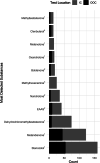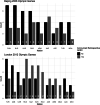Doping practices in international weightlifting: analysis of sanctioned athletes/support personnel from 2008 to 2019 and retesting of samples from the 2008 and 2012 Olympic Games
- PMID: 33415428
- PMCID: PMC7790029
- DOI: 10.1186/s40798-020-00293-4
Doping practices in international weightlifting: analysis of sanctioned athletes/support personnel from 2008 to 2019 and retesting of samples from the 2008 and 2012 Olympic Games
Abstract
Background: The pervasiveness of doping and findings of anti-doping corruption threaten weightlifting's position at the 2024 Olympic Games. Analysing the practices of doping in weightlifters could identify patterns in doping that assist in future detection.
Methods: We analysed publicly available data on sanctioned athletes/support personnel from the International Weightlifting Federation between 2008 and 2019 and announced retrospective Anti-Doping Rule Violations (ADRVs) from the 2008 and 2012 Olympic Games.
Results: There were 565 sanctions between 2008 and 2019 of which 82% related to the detection of exogenous Anabolic Androgenic Steroid (AAS) metabolites and markers indicating endogenous AAS usage. The detection of exogenous AAS metabolites, markers of endogenous AAS usage and other substance metabolites varied by IWF Continental Federation (p ≤ 0.05) with Europe (74%, 11%, 15%) and Asia (70%, 15%, 15%) showing a higher detection of exogenous AAS compared to Pan America (37%, 30%, 33%) and Africa (50%, 17%, 33%). When looking at the 10 most detected substances, the nations with the highest number of sanctions (range 17-35) all had at least one overrepresented substance that accounted for 38-60% of all detected substances. The targeted re-analysis of samples from the 2008 and 2012 Olympic Games due to the discovery of long-term metabolites for exogenous AAS resulted in 61 weightlifters producing retrospective ADRVs. This includes 34 original medallists (9 gold, 10 silver and 15 bronze), the highest of any sport identified by Olympic Games sample re-testing. The exogenous AAS dehydrochloromethyltestosterone and stanozolol accounted for 83% of detected substances and were present in 95% of these samples.
Conclusion: Based on these findings of regional differences in doping practices, weightlifting would benefit from the targeted testing of certain regions and continuing investment in long-term sample storage as the sensitivity and specificity of detection continues to improve.
Conflict of interest statement
Alexander Kolliari-Turner, Brian Oliver, Giscard Lima, John P. Mills, Guan Wang, Yannis Pitsiladis, and Fergus M Guppy declare that they have no conflicts of interest that are directly relevant to the content of this letter.
Figures





Similar articles
-
Analysis of Anti-Doping Rule Violations That Have Impacted Medal Results at the Summer Olympic Games 1968-2012.Sports Med. 2021 Oct;51(10):2221-2229. doi: 10.1007/s40279-021-01463-4. Epub 2021 Apr 9. Sports Med. 2021. PMID: 33835351 Free PMC article.
-
Relationship between Doping Prevalence and Socioeconomic Parameters: An Analysis by Sport Categories and World Areas.Int J Environ Res Public Health. 2022 Jul 30;19(15):9329. doi: 10.3390/ijerph19159329. Int J Environ Res Public Health. 2022. PMID: 35954686 Free PMC article.
-
Strategies that athletes use to avoid detection of androgenic-anabolic steroid doping and sanctions.Mol Cell Endocrinol. 2018 Mar 15;464:28-33. doi: 10.1016/j.mce.2017.01.028. Epub 2017 Jan 24. Mol Cell Endocrinol. 2018. PMID: 28130115 Review.
-
The effects of anti-doping measures on sports performance in weightlifting.J Sports Sci. 2024 Feb;42(4):373-380. doi: 10.1080/02640414.2024.2334483. Epub 2024 Mar 26. J Sports Sci. 2024. PMID: 38531055
-
Androgenic-anabolic steroids and the Olympic Games.Asian J Androl. 2008 May;10(3):384-90. doi: 10.1111/j.1745-7262.2008.00377.x. Asian J Androl. 2008. PMID: 18385900 Review.
Cited by
-
The Uses of Anabolic Androgenic Steroids Among Athletes; Its Positive and Negative Aspects- A Literature Review.J Multidiscip Healthc. 2023 Dec 29;16:4293-4305. doi: 10.2147/JMDH.S439384. eCollection 2023. J Multidiscip Healthc. 2023. PMID: 38170017 Free PMC article. Review.
-
An observational human study investigating the effect of anabolic androgenic steroid use on the transcriptome of skeletal muscle and whole blood using RNA-Seq.BMC Med Genomics. 2023 May 3;16(1):94. doi: 10.1186/s12920-023-01512-z. BMC Med Genomics. 2023. PMID: 37138349 Free PMC article.
-
Comparison of Olympic-Style Weightlifting Performances of Elite Athletes: Scaling Models Account for Body Mass.Med Sci Sports Exerc. 2023 Dec 1;55(12):2281-2289. doi: 10.1249/MSS.0000000000003252. Epub 2023 Jul 7. Med Sci Sports Exerc. 2023. PMID: 37436931 Free PMC article.
-
Quantifying future Olympic sport selection: a data-driven framework for SDE evaluation and selection.Front Sports Act Living. 2025 Jul 29;7:1596196. doi: 10.3389/fspor.2025.1596196. eCollection 2025. Front Sports Act Living. 2025. PMID: 40799343 Free PMC article.
-
Relative Age Effect Is Widespread among Most Successful Youth, but Not in Senior Olympic Weightlifters.J Hum Kinet. 2025 May 29;98:231-241. doi: 10.5114/jhk/194499. eCollection 2025 Jul. J Hum Kinet. 2025. PMID: 40837504 Free PMC article.
References
-
- Butler N. Weightlifting given December deadline to address doping problems by IOC insidethegames.biz 09 June 2017.
-
- Targeted reanalysis of london and Beijing samples underway ahead of Olympic Games Rio 2016 [press release]. 15 March 2016.
-
- Homewood B. IOC warns weightlifting federation to tackle doping. Reuters. 09 June 2017.
-
- IOC executive board charts the course for future olympic games [press release]. IOC Website, 09 Jun 2017.
LinkOut - more resources
Full Text Sources
Other Literature Sources

